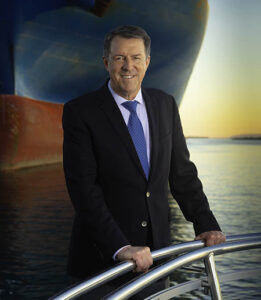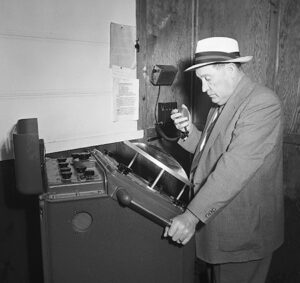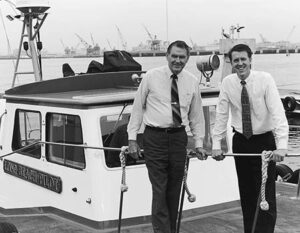Capt. Tom Jacobsen, Third-Generation Leader Of Long Beach Firm Speaks About History And The Future

This year, Jacobsen Pilot Service is celebrating 100 years of doing business at the Port of Long Beach. Jacob Jacobsen, a young immigrant from the secluded island of Mindland, Norway, started the company in 1924. His storied life in the U.S. began in 1909 when he arrived at Ellis Island at age 19. He worked as a carpenter in Seattle, skippered whaling ships off the coast of Alaska, became a U.S. citizen, and served in the U.S. Navy as a lieutenant on troop and cargo transport ships before founding JPS, then known as J.A. Jacobsen & Co.
The company that piloted a few ships a month in 1924 guides thousands of ships a year safely in and out of Long Beach port waters today. These vessels include some of the largest oil tankers, container ships and cruise ships in the global fleet. In addition to piloting vessels through the Port of Long Beach, JPS provides pilot service for several carriers calling at the Port of Los Angeles and U.S. Navy ships calling at Seal Beach.
“The Jacobsen name is synonymous with navigational quality, safety and innovation,” said Long Beach Harbor Commission President Bobby Olvera Jr. “The company’s expertise is foundational to what makes Long Beach a world-class port.”
“Jacobsen Pilot Service is a global leader in every aspect of maritime operations,” said Port CEO Mario Cordero. “The entire supply chain relies on the excellence of JPS every day, and every day the company’s unmatched customer service embodies why Long Beach is the Port of Choice.”
JPS celebrated its centennial anniversary July 20 aboard the Queen Mary. When the legendary ocean liner arrived in Long Beach on Dec. 9, 1967, it was piloted to Berth 122 (now near the Port’s Weyerhaeuser lumber terminal) by JPS Capt. Carl Aultman and Capt. Richard Jacobsen, who became CEO of his father’s company in 1960. In 1971, JPS Capt. Jim Common piloted the Queen Mary’s final move to Pier H, where the vessel – a Long Beach landmark and tourist attraction – remains today.
Ahead of the festivities, third-generation CEO Capt. Thomas Jacobsen talked to Tie Lines about the making of JPS and its core mission and values that continue to serve the company today and will guide it into the future. Built into JPS’ culture is an approach to life’s opportunities and challenges summed up in four words his grandfather often used: Steady as she goes.
Tie Lines: Jacob Jacobsen was 18 when he left Norway and became so skilled at piloting ships that he founded a thriving family business integral to the commercial success of the Port of Long Beach. Doesn’t this story sound like a fairy tale meets the American Dream?
Capt. Thomas Jacobsen: It’s real! My grandfather was the rock of the Jacobsen company. Grandpa was rock solid, honest and worked every day of his life. He was a quiet man for whom work and family came first. When he did speak, he knew what he was talking about and he knew the industry. Having been raised in Norway on the water, he exuded deep knowledge and experience in the maritime industry.

As a young kid, my father would bring me to the pilot station and I’d hear my grandfather talking to the pilots. I’m 10 or 12 years old and seeing him and my dad in action. It was just cool to be a part of that. I’d be fishing off the rocks and they’d give me little projects to do on the pilot boats. I’d clean out the bilges and change the engine oil.
My dad was raised that way by my grandfather. You start out at the bottom in the bilges of the boat. It gives you an appreciation for everything in the company. It takes everybody. Learning that at an early age is important for the company. My dad was also a great example. He’d be in a suit and tie and it would be raining outside and drains would be clogged and he’d say, “Let’s clear out the drains,” and I’d be, “Cool!” He was the first one to roll up his sleeves and take care of stuff, and it has passed down through the culture of the company. We have formal job descriptions in the HR manual but if a lightbulb needs to be changed or if the trash needs to be taken out, everyone pitches in.
T.L: Did you always know you would go into the family business?
T.J.: At an early age I wanted to do this. My dad was pretty clever. He always said, “Have a backup plan because you never know if the company will be around. Make sure you love what you do because something might happen and the company won’t be around.” It’s almost reverse psychology, but it’s a true message. My wife and I did the same thing with our sons. We didn’t want to put pressure on them. We wanted the kids to experience other things. The boys also started down in the bilges doing maintenance on the pilot boats, and they all seemed to start liking the business. Today, our first is in the Merchant Marine, our second is in the Coast Guard, and our youngest is at California Maritime Academy.
T.L.: What don’t most people know about port pilots?

T.J.:A lot of people don’t know what pilots do. They don’t realize that these massive ships moving through our ports have an experienced pilot on board and every ship needs one to protect our city, our environment, our harbor and all the assets coming in and out of the busiest container port complex in the Western Hemisphere. They also don’t know it’s a 24/7 operation. We’ve never shut down since 1924. It’s not easy to keep everything going through sickness and COVID and Christmas and rough weather. It’s normal for us and all the members of the JPS family, but it’s important to pay them respect and honor their commitment.
T.L.: Safety is job No. 1 for JPS. Talk about JPS’ safety record:
T.J.: During my time as president, we’ve had a perfect record of no accidents caused by pilots. It was mostly true under my father when there were a few instances of pilot error. In my grandpa’s time, it was a totally different world. Accidents were expected. The tugboats weren’t reliable, the tug lines would break, and that’s if you had a tug. If you broke three pilings, that was just part of the job.
My dad started our training program and set the path going forward for continual improvements since (the) 1960s. It became crucial to have an accident-free company because we had to insure ourselves and the legal costs were getting high. Our program has led the way for pilot training for the country. We do our training in-house. We use simulators at Cal Maritime Academy or Orange Coast College but it’s our pilots teaching our young pilots. Perfecting our training program is ongoing.
If there is an incident anywhere in the world, we will track it and look at how to mitigate the risk. We started doing that on our own and it’s become standard practice for pilot organizations worldwide. The biggest thing in our industry is prevention. We have to prevent accidents and never rest on our laurels. It’s complacency that kills, so we have to prevent accidents before they happen. It’s an active and ongoing process. Our senior pilots meet regularly to review everything and what we can improve to do better.
Of course we’ve studied incidents like the COSCO Busan in San Francisco Bay and the Exxon Valdez in Alaska, and we’re following what’s happening with the Baltimore bridge, which is still under investigation. But we also look at small incidents and close calls that don’t make headline news, to keep us sharp.
The biggest challenge we face today is the ongoing increase in the vessel size. These ships are pushing the limits in all directions. The widths are so wide and the depths are so deep. Bringing in these ships without having an accident requires the highest level of skill and experience. If my grandpa were here, the size of the ships would be the first thing that would amaze him.
T.L.: What role does technology play?
T.J: JPS embraced technology from the very beginning. Radar technology was developed by the Navy during World War II and my grandfather learned its benefits firsthand while piloting Navy ships in and out of Long Beach during those years. In 1949, my grandfather installed the first shoreside radar system for commercial use in the U.S.
Dad was into technology, too. He kept up with the latest and greatest radar technology, and he and our friends from Pacific Radar Co. figured out how to network remote radars to give the pilot station 100% coverage of the Port’s waterways. That was also a first.
Of course, we use technology today to benefit the way we do business. We have a lot of smart people in our company and we try to harness the best ideas and use them for something that’s practical. Our newest boats, the Orion and the Polaris III, are state-of-the-art, but they are also very practical and economical workboats. It’s important to have something that’s built to last, and we were able to do that by involving our team in the building process from start to finish. That’s pretty much our approach to everything we do.
If my grandfather were here, I think he would be blown away by our carry-aboard navigation systems, called Portable Pilot Units. Our equipment has centimeter accuracy, which is just amazing, and the most detailed, most accurate charts available anywhere. All of this is displayed on a regular iPad.
T.L.: Since JPS has always been ahead of the curve in technology, what’s on the horizon?
T.J.: We’re all trying to put our head around that question. We don’t see anything imminent, but we’re watching AI. How is AI going to impact the industry and autonomous ships? How do we handle that? We’re always looking to see what’s coming because we have to be ready. As for AI replacing pilots, that will not happen anytime soon. I can see AI assisting pilots, but it will be a long time before pilots are replaced. If I could, I would invent something that gets our pilots on board ships a little more efficiently and safer. That hasn’t changed for hundreds of years. They still board and leave ships by rope ladder. Some pilot groups use a helicopter, but that’s expensive and being lowered onto the deck by wire is not completely safe either.
T.L.: JPS is known for scouting and recruiting pilots. It sounds a lot like how professional sports teams recruit top-notch players. Is this a fair analogy?
T.J.: I never thought of it that way, but that’s exactly what we do. We are always looking for the rising stars. We invite them down to ride ships with us, and we get our people to meet them to see if they have talent and experience and they are team players. When we hire somebody, we’re hiring with the intent to keep that person their whole career. We want this to be a perfect fit for them and for us. It’s worked well for us. No one leaves. From pilots and boat operators, to bookkeepers, most people work here 30 or more years. Ideally, pilots are in their early to mid-30s when they join us because they have 10 years of experience at sea and we have them for many more years, all the way to retirement. We had to set a mandatory retirement age of 70 because sometimes pilots don’t want to retire. They have to retire because it’s not safe for them to keep climbing rope ladders at the age of 70 or more.
T.L.: What other business practices keep JPS strong as a company?
T.J.: In 1964, my dad made it mandatory for all our pilots to own shares in JPS. We want people who have an interest in the safety of our company. If we have an accident, it’s going to affect everyone. If we succeed, everyone benefits.
T.L.: Over the last century, JPS has weathered historic disruptions – the Great Depression, World War II, containerization, the Great Recession and COVID – and become a bedrock of operations at the Port of Long Beach. To what do you attribute JPS’ success?
T.J.: A lot of luck is involved in surviving 100 years. When my grandfather started out here, a lot of his shipping buddies said, “You’re going to pilot in Long Beach? It’s just a bunch of mudflats.” But the leaders of the Port and the City were visionary. They saw the potential for this Port and the growth in trade.
I credit my grandfather for laying the foundation for customer service, safety and our work ethic. I credit my father for building on what my grandfather created by perfecting the business side to help us succeed in the future. My generation is fortunate that they passed down their skills and experience. We’re very lucky to be where we are.
And while we’ve continued to adapt to all the market and industry changes, when it comes to piloting ships not much has changed. Our mission has been constant and there have been no changes to the basics of our operation. We’ve always been focused on precision, safety and customer service. These core values will always be our guiding light.
ORIGINAL ARTICLE:
https://polb.com/port-info/news-and-press/steady-as-she-goes-jacobsen-pilot-service-at-100-07-30-2024/


